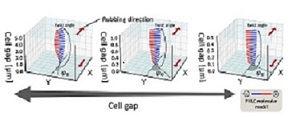Research on basic physical properties of liquid crystal devices

Just as a substance has a measure of the ease of electricity flow (electrical resistance), it may be useful to have some measure or index.
Liquid crystal displays (LCDs) may also differ depending on people's tastes simply by saying that they are "easy to see" or "beautiful."
Since the LCD is a device that humans use visually, it is necessary to index the electrical and optical properties.
Kimura Laboratory is working on establishing a method for determining indicators (device parameters) related to LCD operation.

One of the various device parameters is "interface anchoring energy".
It is a parameter that determines the operation of the LCD.
The understanding is very difficult, and international standardization is impossible.
We have been consistently working on that establishment for over 25 years.
We are proud that some of them have been embodied as measuring devices and put on the market, and have played a part in the development of LCDs to date.
Research on Flexible & Printed Electronics

Most electronic devices are mainly composed of semiconductors made of silicon.
It is said that organic substances will be used as semiconductors instead of silicon in the near future.
The merits of using organic substances are the ability to make bendable devices (flexibility) and the possibility of device manufacturing technology for printing technology applications such as 3D printers (printed electronics).

At Kimura Laboratory, we are working on LCD manufacturing technology using slit coaters (some people call them nozzle coaters, die coaters, lip coaters, etc.).
The advantage is that molecules can be arranged without using the "liquid crystal molecular alignment film" which is a necessary member characteristic of LCDs.
This not only makes it possible to reduce costs by reducing the number of parts and processes, but also makes it possible to realize LCDs made of plastic parts, which was previously only possible with glass.
As a result, we were able to actually make a flexible LCD that can be bent freely as shown in the picture.
Basic research on power storage and power generation devices

Batteries made of lithium, a rare earth element, are widely used as batteries for electric vehicles and mobile devices.
Lithium is a rare metal that is worried about depletion, and it relies heavily on imports.
By the way, automobiles that use gasoline or light oil as fuel also have batteries, but most of them are made of lead.
Although lead is toxic, it has a recycling rate of almost 100% in Japan and has excellent discharge characteristics, so it is widely used as an uninterruptible power supply for computers.
If the charging characteristics of lead batteries are as good as lithium, lead batteries will be widely used again because expensive lithium will not be used.

Based on my experience in LCD research, I am working on the "rediscovery" of lead batteries.
We are working on research using an atomic force microscope with the aim of elucidating the key "mechanism" that improves charging characteristics.
Furthermore, we are taking on the challenge of researching organic thin-film solar cells by utilizing the knowledge we have cultivated in our research on liquid crystals.
Research on organic semiconductors

Electronic devices using organic semiconductors can be made through solution-coated functional ink and various printing processes, so it is expected that conventional semiconductor processes will be changed to simple and energy-saving. Besides, low-temperature process using their materials is also expected to realization of flexible electronic devices. In order to realize these attractive features, we must improve to achieve both high performance and high reliability for the various organic devices currently under development.
In our laboratory, we are studying methods for control of the molecular orientation to various solid-state organic semiconducting materials such as photoelectric conversion and fluorescence, based on an approach that utilizes fluids which molecules has self-assembly characteristics, i.e. liquid crystalline materials. By elucidating the mechanism leading to precise control of molecular alignment, we aim to innovate technology of organic electronics utilizing many knowledges of liquid crystal devices that are compatible with solution coating and printing processes.
.jpg)
To utilize the solar energy efficiently for enhancement of human food production, our laboratory focuses on improvement of the growth rate of agricultural crops by efficient photosynthesis reaction. We have found that uniaxially-aligned organic fluorescent molecules enabled emission of polarized fluorescent. From these findings, we are studying on the development of wavelength/polarization conversion films by solution-caoting process which specialized light absorption characteristics of chlorophyll. Conventionally, solid-state organic fluorescent materials are known to exhibit almost no photoluminescence due to the problem of concentration quenching. By using a fluorescence spectrophotometer, we observed the emission spectra of solid-state thin film composed of red-light emitting organic fluorescent molecules and liquid-crystalline polymer. We will keep challenging for further improving fluorescence efficiency and controlling of suitable polarization characteristics for plant photosynthesis.
Research on ferroelectric nematic liquid crystals

In the 1980s, ferroelectric smectic liquid crystals attracted researchers' interest not only from an academic but also from an industrial point of view. Although they were put into practical use as liquid crystal displays in 1994, they did not succeed in the market, due to some weakness as such that it was difficult to control molecular orientation and was susceptible to mechanical shock.
Ferroelectric nematic liquid crystals were discovered three years ago, and research groups worldwide are competing to advance their research. Our laboratory is conducting research by using the molecular orientation control technology and molecular orientation evaluation technology we have cultivated over the years.

As for recent results, we have presented our comprehensive interpretation of polar orientation structure and interfacial anchoring energy at international conferences and English journals.
To explain the experimental results, we also perform simulations based on continuum theory and molecular dynamics simulations.
